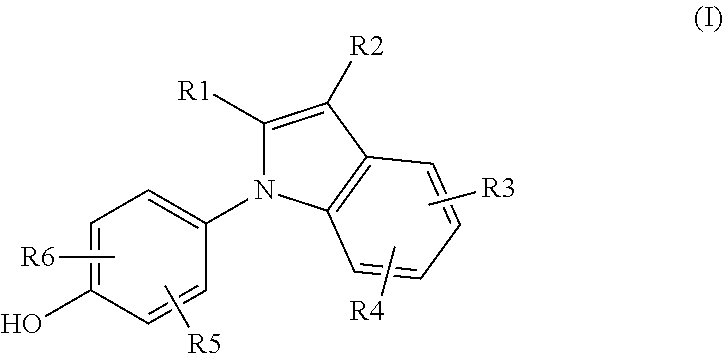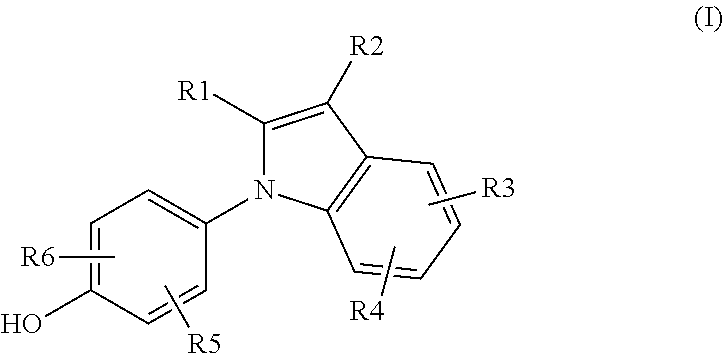Novel Estrogen Receptor Ligands
a technology of estrogen receptors and ligands, applied in the field of estrogen receptor ligands, can solve the problems of preventing widespread and more chronic use of estrogen
- Summary
- Abstract
- Description
- Claims
- Application Information
AI Technical Summary
Benefits of technology
Problems solved by technology
Method used
Image
Examples
example 1
2-Bromo-1-(4-hydroxy-phenyl)-1H-indole-3-carbonitrile (E1)
[0107]
[0108]Step (a): 1 eq 3-Cyanoindole, 2 eq 4-iodoanisole, 2.1 eq potassium phosphate, 4.5 eq N,N′-dimethylethylenediamine and 0.2 eq copper(I) iodide were mixed in an oven-dried vial and toluene was added. The mixture was stirred under N2-atmosphere at 110° C. over night. The reaction mixture was cooled to rt, filtered and evaporated in vacuo. The crude product was purified on silica using n-heptane: EtOAc (4:1) as mobile phase.
[0109]Step (b): 1-(4-Methoxy-phenyl)-1H-indole-3-carbonitrile was dissolved in dry THF and cooled to −78° C., 1.1 eq t-BuLi was added drop wise and the mixture was stirred for one hour. A solution of 1.3 eq 1,2-dibromotetrachloroethane in dry THF was added and the mixture was stirred for 4 hours while slowly warming it up to rt and then quenched by addition of H2O. The reaction mixture was diluted with DCM, phases were separated and the organic phase was evaporated in vacuo. The crude product was p...
example 2
1-(4-Hydroxy-phenyl)-2-thiophen-3-yl-1H-indole-3-carbonitrile (E2)
[0111]
[0112]To 2-bromo-1-(4-hydroxy-phenyl)-1H-indole-3-carbonitrile (Example 1) was added 2 eq 3-thiopheneboronic acid, 2.1 eq potassium carbonate and 10 mol % tetrakis(triphenylphosphine) palladium. THE: EtOH: H2O (4:1:0.5) was added and the vial was flushed with nitrogen, sealed and stirred at 100° C. for 48 hours. The reaction mixture was cooled to rt, diluted with H2O, extracted with EtOAc and filtered through silica. The organic phase was evaporated to dryness and the crude product was subjected to reversed phase preparative HPLC. Appropriate fractions were combined, evaporated, and identified by 1H-NMR and LC / MS. Purity was determined by analytical HPLC. ES / MS m / z: 317.9 (M+H), 314.8 (M−H); 1H NMR (acetone-d6, 500 MHz): 7.73 (m, 1H), 7.62 (dd, 1H, J=1.3, 2.9 Hz), 7.54 (dd, 1H, J=2.9, 5.0 Hz), 7.37-7.30 (m, 2H), 7.26 (m, 2H), 7.18 (m, 1H), 7.15 (dd, 1H, J=1.3, 5.0 Hz) and 7.03 (m, 2H).
example 3
2-(3-Cyano-furan-2-yl)-1-(4-hydroxy-phenyl)-1H-indole-3-carbonitrile (E3)
[0113]
[0114]2-Bromo-1-(4-hydroxy-phenyl)-1H-indole-3-carbonitrile (Example 1, 40 mg, 0.13 mmol, 1 eq), 2-tributylstannanyl-furan-3-carbonitrile (63.5 mg, 0.17 mmol, 1.3 eq) and dichlorobis(triphenylphosphine)palladium(II) (9 mg, 0.01 mmol, 0.1 eq) were weighed into a microwave vial. Dioxane (1 ml) was added, the vial was flushed with nitrogen and capped. The reaction mixture was irradiated at 130 degrees for 30 min in the microwave and then the solution was filtered. Saturated aqueous ammonium chloride solution (5 ml) was added and the mixture was extracted several times with DCM. The combined DCM phases were passed through a phase separation membrane and evaporated. The crude product was purified by a quick silica gel flash chromatography, using n-heptane: ethyl acetate (7:3) gradient, to remove the remaining tin reagent rests. Appropriate fractions were collected and evaporated, dissolved in acetonitrile (1 m...
PUM
 Login to View More
Login to View More Abstract
Description
Claims
Application Information
 Login to View More
Login to View More - R&D
- Intellectual Property
- Life Sciences
- Materials
- Tech Scout
- Unparalleled Data Quality
- Higher Quality Content
- 60% Fewer Hallucinations
Browse by: Latest US Patents, China's latest patents, Technical Efficacy Thesaurus, Application Domain, Technology Topic, Popular Technical Reports.
© 2025 PatSnap. All rights reserved.Legal|Privacy policy|Modern Slavery Act Transparency Statement|Sitemap|About US| Contact US: help@patsnap.com



